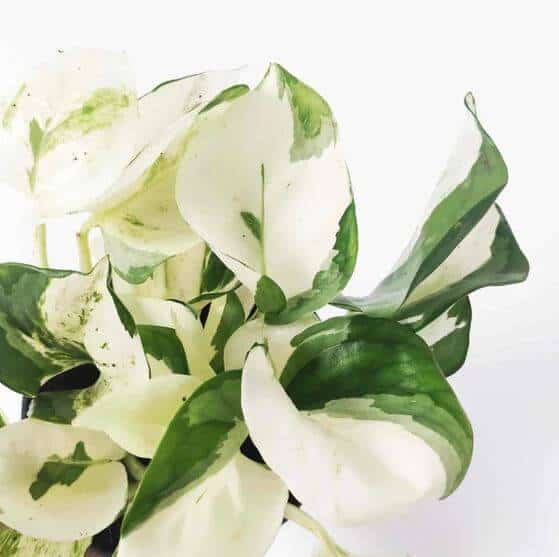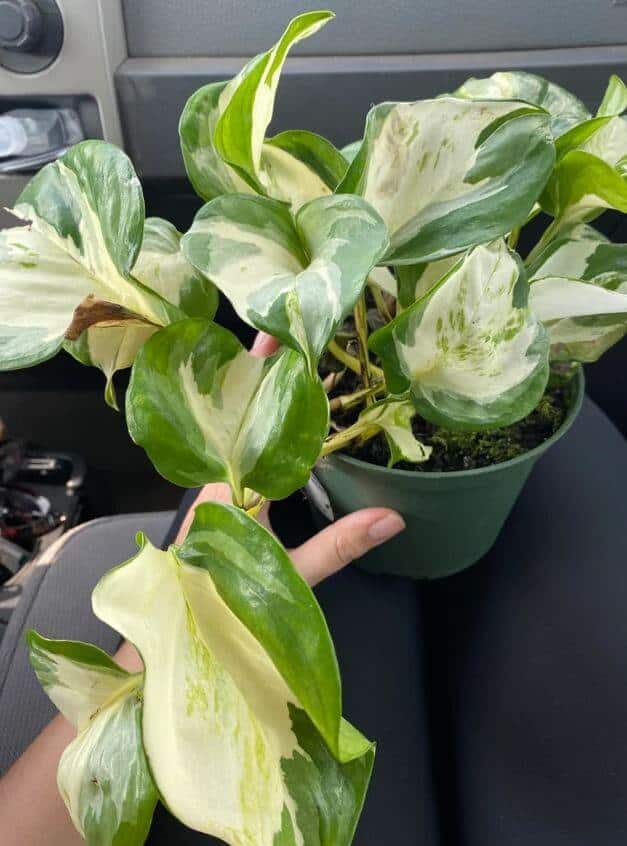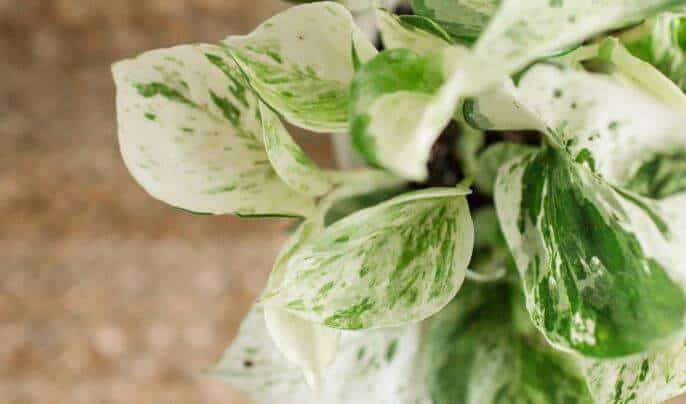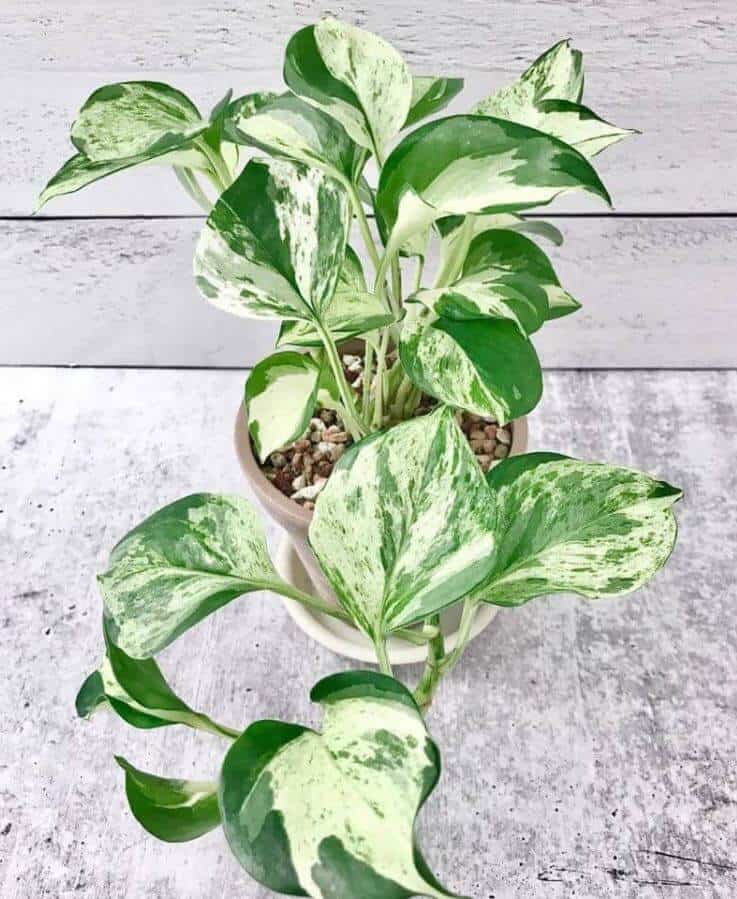Last Updated on September 9, 2023 by a Friendly Gardener
Pothos plants are among the easiest houseplants to cultivate and care for. They are both beautiful and forgiving and there are numerous varieties. So. If you like the idea of a Pothos but want something unique, the Harlequin Pothos is exactly that.
The Harlequin Pothos is a striking plant with lovely patterns on its foliage. Aside from being beautiful, it is also a rare variety. Other similar Pothos plants may be labeled as a Harlequin, but you’ll need a reputable nursery to ensure your plant is indeed a Harlequin.
Belonging to the Araceaefamily, this Pothos finds its native habitat in Southeast Asia. It boasts highly variegated leaves with large splotches of white on green accounting for its name. Botanically named the Epipremnum Aureum Harlequin, it may be confused with the Manjula Pothos or Epipremnum Manjula. But these are two very distinct varieties. Foliage is similar but there is a difference. The Harlequin will feature more white and less green than the Manjula Pothos and the Harlequin is rarer.
Harlequin Pothos Plant Care

Despite its beauty and rarity, the Harlequin Pothos plant is perfect for beginner indoor gardeners. It is tolerant of a wide variety of environmental conditions. Should you neglect your plant for a bit, forgetting to water it, your Harlequin may not thrive, but it is unlikely that it will die. Nonetheless, good care will ensure a thriving and happy plant.
Soil
Pothos plants do best in well-draining soil. You can use a quality standard potting mix and add a fistful or two of perlite or coco coir to ensure drainage and soil aeration. Soil should be slightly acidic with a pH between 6 and 6.5. If you wish to blend a growing medium, try one part perlite, two parts peat moss, and one part pine bark.
Light
A Harlequin Pothos enjoys bright, indirect light. It will not do well when exposed to direct sunlight. While it can adapt to low light conditions, it will flourish with bright light. If your home or office has few windows and little natural light, consider supplementing with an artificial grow light.
The Harlequin will not do well in dark locations. To evaluate lighting observe the foliage. If they tend to turn yellow or brown, your plant may require more light, or plants that lose variegation are signaling a lack of adequate light.
Water

Ideally, your Harlequin Pothos will need to be watered when the top two inches of the soil bed have dried out. Consider a weekly watering. Do not overwater your plant as this can lead to the development of root rot.
In arid climates, watering twice weekly may be warranted. In autumn and winter reduce watering to once every ten days to two weeks. If foliage begins to droop, your plant is thirsty. An extended period without water can result in leaf drop.
Humidity
Natives of the tropics, the Harlequin prefers humid locations. Generally, home humidity of 50% or above should suffice. If your air is dry due to heating or air conditioning, you should increase the humidity with a space humidifier or by placing a pebble tray underneath your plant. Grouping several plants together can help because this will create a microclimate. For an immediate short-term solution, mist your Pothos.
A plant will indicate that humidity is too low by
- Leaves drooping
- Brown edges on leaves
- Wilting
- Yellowing foliage
Temperature

As a tropical plant, the Harlequin Pothos enjoys environmental temperatures that measure between 60° and 75°F. Nighttime temperatures should not drop below 50°F. If the temperature drops and it is too cold for your plant, it may experience leaf drop.
Feeding
A Pothos Harlequin will benefit from a monthly feeding during its growing season. Use a liquid fertilizer for foliage plants that is higher in nitrogen. To prevent burning the root system, consider diluting the fertilizer to half-strength. You can also opt to use slow-release fertilizer pellets as an alternative.
Pruning
Pothos species are trailing plants although they can be pruned and trained to grow upright. These plants generally grow in length, so pruning becomes crucial. When left without the occasional trim, vines can become leggy.
Repotting a Harlequin Pothos

Pothos plants are rapid growers, so plan on repotting at least once annually. Check your plant for crowding of its root system at the beginning of spring or at the end of summer and repot accordingly if necessary.
Harlequin Pothos Propagation
The simplest way to propagate a Pothos is to root a stem cutting in water. When preparing a cutting, at least one leaf node should be underwater, while leaves should be kept above water. A glass jar is ideal for rooting as it will allow you to keep an eye on root development. Use collected rainwater or filtered water for rooting purposes. Attached leaves should not be permitted to touch the water as this may cause rotting. Healthy roots should develop within two months, at which time your cutting can be transplanted into soil.
Pests and Problems
Spider mites are particularly fond of the Pothos plant. They will feed on new leaves and leave holes. You may also notice webbing on the undersides of foliage. Treat your plant with Neem oil or insecticidal soap spray.
If your plant appears to have soft tissue, it may have a fungal infection. Check your soil for sogginess and remove any excess water. If this is not possible, consider repotting. Yellowing foliage can indicate a fungal infection or a watering problem. Wilting, on the contrary, indicates that your plant requires watering.
Yellow foliage can also indicate a pest infestation or too much direct sunlight.
Harlequin Pothos Toxicity
Pothos plants are mildly toxic to family pets. They contain calcium oxalates that if chewed can cause burning and swelling. If leaves are ingested, vomiting, diarrhea, drooling, and difficulty breathing can follow. Consult a veterinarian if you suspect your pet has munched on your plant.
The Harlequin Pothos vs. the Manjula Pothos

Although you may come across one of the plants labeled as a Manjula Harlequin Pothos, this is simply a Manjula. A true Harlequin Pothos will be more variegated. Unfortunately, they are difficult to distinguish as both feature large teardrop-shaped leaves with mottled patterns. However, the Harlequin Pothos will have more white variegation and less light green when compared to a Manjula. Both varieties will make stunning additions to your indoor garden.

